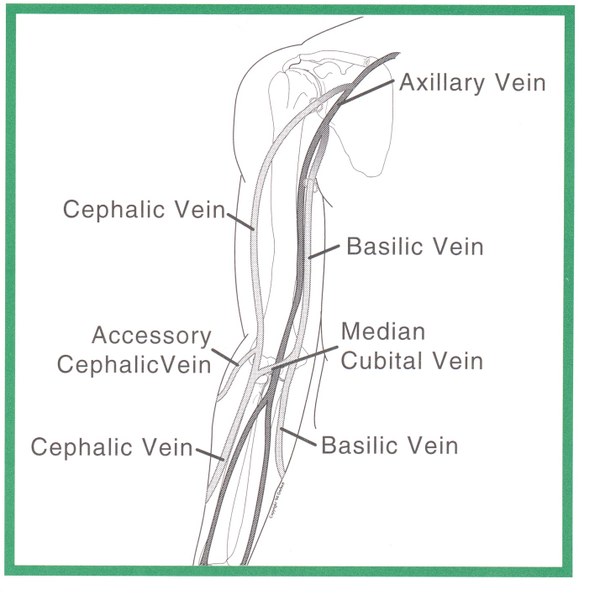PICC Lines

What is a PICC Line?
PICC stands for “Peripherally Inserted Central Catheter”. It is a silicone rubber tube, which is placed in the antecubital fossa of the arm (the elbow crease) with the tip of the catheter lying in the superior vena cava, the large vein at the entrance to the right atrium of the heart. It is held in place by two small stitches in the skin. Their use appears to be associated with a lower rate of infection.
This may be due to the fact that the antecubital fossa is less colonised with normal skin “bugs” and is less oily and moist than the chest and neck.
For smaller children or babies the same line is used but will be placed on the chest, this is called an uncuffed skin tunneled central venous catheter. It is tunneled under the skin of the chest wall to a vein in the neck. From there it is threaded through a large vein into the right atrium of the heart.
The PICC can stay in position for many months without causing any problems.There is a special tip at the end of the catheter called a Groshong™ valve.
This is a 3-position, pressure sensitive valve. It allows fluid infusion and blood aspiration. When the PICC is not in use, the valve maintains catheter patency by restricting the backflow of blood and preventing air embolism by remaining closed. This means there is no need to use clamps and heparin between each use of the line.
What care does the catheter require?
The catheter is looked after aseptically which involves careful hand washing, wearing gloves and being very clean. You will also notice a cap on the end of the catheter to protect the end.
When not in use, the PICC line has to be flushed once a week with a saline solution.
The exit site dressing also needs to be changed once a week. The old dressing is removed and the skin is cleaned with an antiseptic solution. A small loop is placed in the line and steri-strips help to secure it. A clean dressing is then reapplied. If the dressing becomes loose, wet or dirty, it must be changed immediately.
Safety aspects For PICCs infection
Observe the exit site (where the tube comes out of the arm) for any signs of infection:
- Redness
- Swelling
- Pain
- Discharge ie blood or pus
If this should occur take your child to your local hospital or call your paediatric community nurse for assessment, swab and blood cultures. An infection needs to be treated promptly as it may progress to a line infection (infection inside the catheter).
If your child’s temperature is 38.0ºc or above go straight to your local hospital. This is because when children are feverish and unwell, they are very susceptible to infection and the PICC line is a possible source of infection.
If the dressing is soiled with blood or looks wet under the dressing, it will need changing, as this increases the risk of infection. Otherwise the dressing needs changing once a week, your community team will do this.
Try to keep the PICC - including the ends, dry. Tape it up out of the way when your child is having a bath.
If the cap falls off, wash your hands well, clean the end of the PICC with an alcowipe being careful not to touch the end, and put on a new cap. Never put back on an old cap. Please tell your community nurse so that blood cultures can be taken.
Accidental removal of line
Please ensure that the PICC is securely fastened with steri-strips and that it is completely covered to half way down the hub with IV 3000. If possible the PICC should be looped underneath the dressing to prevent accidental damage or dislodgement. When not in use the area around the PICC can be covered with a bandage to provide extra security.
If the line is accidentally removed, pressure should be applied, for 5 to 10 minutes, to the exit site, to stop any bleeding.
If the line falls out, take your child and the PICC to the ward at your local hospital.
Broken line
You will be given some blue clamps to take home with you. Ensure you carry them around with you at all times.
If the PICC breaks, or you can see a hole in it, clamp the line between the exit site and the break. The line can be mended, so wrap a piece of occlusive dressing (e.g. a small IV3000) around the break to ensure that the line doesn't get dirty. Then place a piece of gauze around the line before you apply the clamps. These prevent air getting in and blood coming out of the line.
Use the third section of the blue clamps (at the bottom of the "V"), as the first section may damage the line further, and the second section won't clamp the line sufficiently. If you don't have your blue clamps on you, bend the line over and hold it with your fingers. Take your child up to your local hospital to have them assessed and to check that the line has been clamped properly. They will make arrangements with us to have it repaired
If you do not have the clamps with you, you should bend the line over and hold with your fingers and ring for an ambulance.

